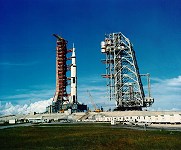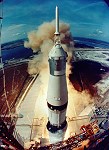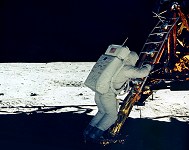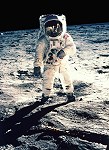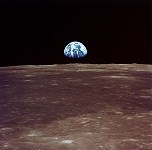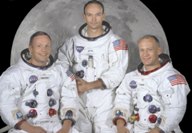41 years since man set his foot on MOON - photos,videos
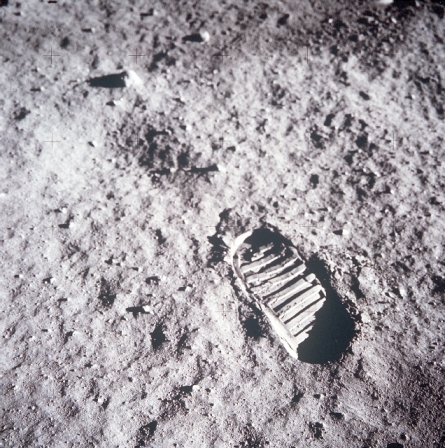 |
| Here men from the planet Earth first set foot on the Moon—July 1969 A.D.—We came in peace for all mankind - reads the plaque that was left on moon |
On July 20, 1969, at 10:56 p.m. ET, Apollo 11 astronaut Neil Armstrong stepped off the "Eagle" onto the surface of the moon and said, "That's one small step for man, one giant leap for mankind."
Forty one years ago, men from Earth began for the first time to leave our home planet and journey to the moon.The Apollo 11 launch date had arrived with just months to spare: Nine years earlier, it all started on May 25, 1961, when President John F. Kennedy announced the goal of sending astronauts to the moon before the end of the decade. Coming just three weeks after Mercury astronaut Alan Shepard became the first American in space, Kennedy's bold challenge set the nation on a journey unlike any before in human history.
And finally on July 20, 1969, half a billion people watched as Neil Armstrong became the first person to set foot on the moon. "That's one small step for man, one giant leap for mankind," he said, before imprinting his boot in the lunar dust. The televised images were relayed to Earth from a camera mounted on a leg of the Apollo 11 lunar module. Armstrong was joined on the moon by fellow crewmember Edwin "Buzz" Aldrin. Above them a third astronaut, Michael Collins, orbited in the mission's command module.
The successful Apollo 11 moon landing on July 20, 1969, ushered in an era of moon exploration that has so far gone unrivaled.Man's dream of going to the moon was fulfilled. The most exciting adventure in human memory neared its climax as the two men prepared to step out on the lunar surface, while their fellow crew member, Mike Collins, kept vigil in his orbiting command module, Columbia, 70 miles above.
It is impossible to compare this exploit with the epic feats of the great 15th- and 16th-century navigators, of the 20th-century polar explorers,
or of Lindbergh in 1927. The differences are too profound, and one of the most important of those differences is that the whole world was watching.
Image Gallery
Click on Images - they will zoom out in Place----
The Mission
Eight years of hard work by thousands of scientists and engineers came to fruition on July 20, 1969, when Apollo 11 commander Neil Armstrong stepped out of the lunar module and took "one small step" in the Sea of Tranquility, calling it "a giant leap for mankind."
Two thousand feet above the Sea of Tranquillity, the little silver, black, and gold space bug named Eagle braked itself with a tail of flame as it plunged toward the face of the moon. The two men inside standing like the motorman in a 19th—century trolley car-strained to see their goal. Guided by numbers from their computer, they sighted through a grid on one triangular window.
After launch, the spacecraft was inserted into lunar orbit about 76 hours into the mission. After a rest period, Armstrong and Aldrin entered the Lunar Module preparing for descent to the lunar surface. The two spacecraft were undocked at about 100 hours, when the Command and Service Modules separated from the Lunar Module. The spacecraft landed in the Sea of Tranquillity at 4:18 p.m. EDT. Afterwards, they ate their first meal on the Moon and decided to begin the surface operations earlier than planned.
A Lunar Module camera provided live television coverage of Armstrong setting foot on the lunar surface at 10:56 p.m. EDT. Just as he stepped off the Lunar Module Neil Armstrong proclaimed, "That's one small step for a man, one giant leap for mankind." Aldrin emerged soon after, setting foot on the lunar surface at 11:16 p.m. EDT. Aldrin evaluated his ability to operate and move about and was able to move about rapidly and with confidence. Forty-seven pounds of lunar surface material were collected to be returned for analysis. The surface exploration was concluded in 2½ hours, when the crew re-entered the lunar module.
After lunar ascent, the Lunar Module docked with the Command and Service Modules at 128 hours. The crew transferred into the Command and Service Modules, the ascent stage was jettisoned and they prepared for trans-Earth injection. Only one midcourse correction was required.Atmospheric entry phase was normal, and the command module landed in the Pacific Ocean at 195¼ hours.
But above all, Apollo 11 was a triumph of the human spirit. As Buzz Aldrin said in a TV broadcast while coming home from the moon, "This has been far more than three men on a voyage to the moon ... This stands as a symbol of the insatiable curiosity of all mankind to explore the unknown."
At the President's dinner honoring the astronauts shortly after their release from quarantine, Neil Armstrong brought tears to the eyes of many when he said, in a voice filled with emotion:
"We hope and think ... that this is the beginning of a new era, the beginning of an era when man understands the universe around him, and the beginning of the era when man understands himself."
Videos
The real events of the Apollo 11 Lunar Landing,from the National Geographic Channel. [Re-edited for Gamma Correction]
Write Up under Refinement - Comments Invited- All image and info credit : NASA

